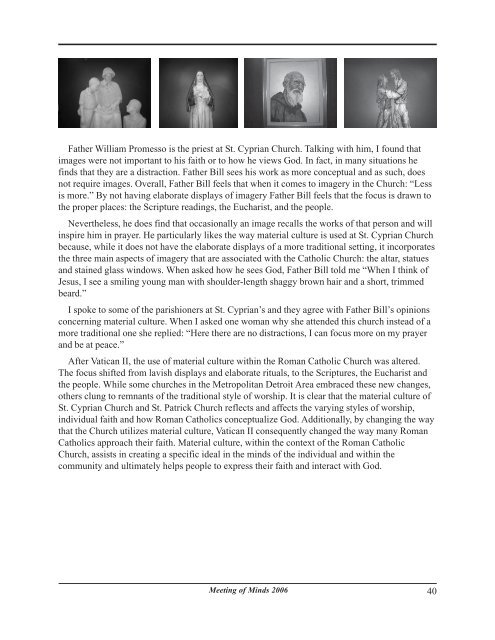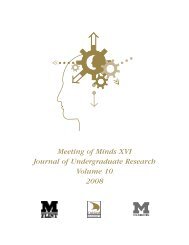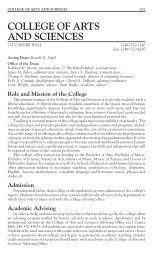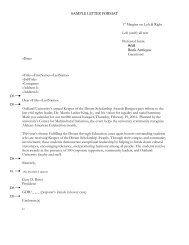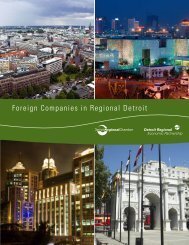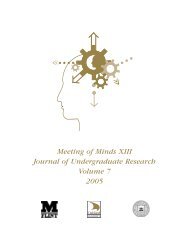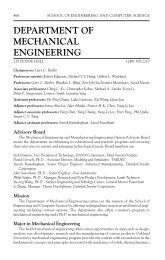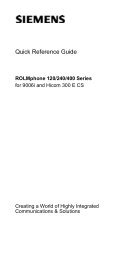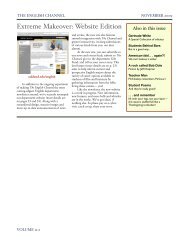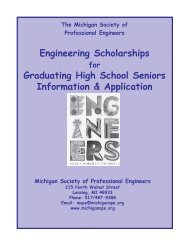MOM 2006 journal for pdf.pmd - University of Michigan-Flint
MOM 2006 journal for pdf.pmd - University of Michigan-Flint
MOM 2006 journal for pdf.pmd - University of Michigan-Flint
Create successful ePaper yourself
Turn your PDF publications into a flip-book with our unique Google optimized e-Paper software.
Father William Promesso is the priest at St. Cyprian Church. Talking with him, I found that<br />
images were not important to his faith or to how he views God. In fact, in many situations he<br />
finds that they are a distraction. Father Bill sees his work as more conceptual and as such, does<br />
not require images. Overall, Father Bill feels that when it comes to imagery in the Church: “Less<br />
is more.” By not having elaborate displays <strong>of</strong> imagery Father Bill feels that the focus is drawn to<br />
the proper places: the Scripture readings, the Eucharist, and the people.<br />
Nevertheless, he does find that occasionally an image recalls the works <strong>of</strong> that person and will<br />
inspire him in prayer. He particularly likes the way material culture is used at St. Cyprian Church<br />
because, while it does not have the elaborate displays <strong>of</strong> a more traditional setting, it incorporates<br />
the three main aspects <strong>of</strong> imagery that are associated with the Catholic Church: the altar, statues<br />
and stained glass windows. When asked how he sees God, Father Bill told me “When I think <strong>of</strong><br />
Jesus, I see a smiling young man with shoulder-length shaggy brown hair and a short, trimmed<br />
beard.”<br />
I spoke to some <strong>of</strong> the parishioners at St. Cyprian’s and they agree with Father Bill’s opinions<br />
concerning material culture. When I asked one woman why she attended this church instead <strong>of</strong> a<br />
more traditional one she replied: “Here there are no distractions, I can focus more on my prayer<br />
and be at peace.”<br />
After Vatican II, the use <strong>of</strong> material culture within the Roman Catholic Church was altered.<br />
The focus shifted from lavish displays and elaborate rituals, to the Scriptures, the Eucharist and<br />
the people. While some churches in the Metropolitan Detroit Area embraced these new changes,<br />
others clung to remnants <strong>of</strong> the traditional style <strong>of</strong> worship. It is clear that the material culture <strong>of</strong><br />
St. Cyprian Church and St. Patrick Church reflects and affects the varying styles <strong>of</strong> worship,<br />
individual faith and how Roman Catholics conceptualize God. Additionally, by changing the way<br />
that the Church utilizes material culture, Vatican II consequently changed the way many Roman<br />
Catholics approach their faith. Material culture, within the context <strong>of</strong> the Roman Catholic<br />
Church, assists in creating a specific ideal in the minds <strong>of</strong> the individual and within the<br />
community and ultimately helps people to express their faith and interact with God.<br />
Meeting <strong>of</strong> Minds <strong>2006</strong> 40


